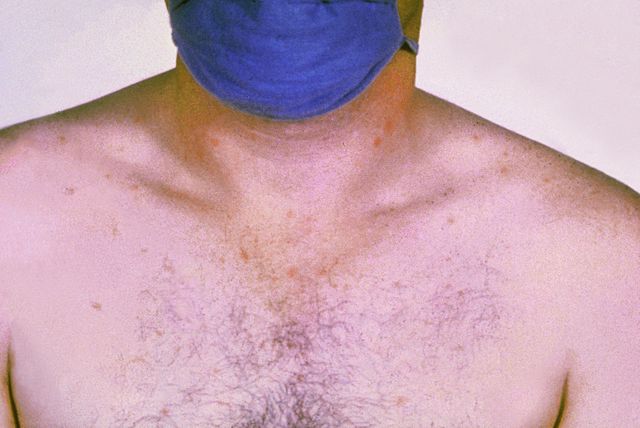 |
This is a file from the Wikimedia Commons. Information from its description page there is shown below.
Commons is a freely licensed media file repository. You can help.
|
| Description |
English: Rose spots on the chest of a patient with typhoid fever due to the bacterium Salmonella typhi. Symptoms of typhoid fever may include a sustained fever as high as 103° to 104° F (39° to 40° C), weakness, stomach pains, headache, loss of appetite. In some cases, patients have a rash of flat, rose-colored spots.
Polski: Wyspka skórna w przebiegu duru brzusznego.
Deutsch: Roseolen auf der Brust eines an Typhus erkrankten Patienten.
Español: Roseola tifoidea, signo clínico típico de la enfermedad.
Català: Maculopàpules de colour salmó de la salmonel·la.
עברית: פריחה על חזה של חולה בטיפוס הבטן.
|
| Date |
1964 |
| Source |
 |
This media comes from the Centers for Disease Control and Prevention's Public Health Image Library (PHIL), with identification number #2215. Note: Not all PHIL images are public domain; be sure to check copyright status and credit authors and content providers.
|
|
| Author |
- Photo Credit:
- Content Providers(s): CDC/Armed Forces Institute of Pathology, Charles N. Farmer
|
Permission
( Reusing this file) |
PD-USGov-HHS-CDC (None - This image is in the public domain and thus free of any copyright restrictions. As a matter of courtesy we request that the content provider be credited and notified in any public or private usage of this image.)
|
Licensing
| Public domainPublic domainfalsefalse |
 |
This image is a work of the Centers for Disease Control and Prevention, part of the United States Department of Health and Human Services, taken or made as part of an employee's official duties. As a work of the U.S. federal government, the image is in the public domain.
česky | Deutsch | English | español | eesti | suomi | français | italiano | македонски | Nederlands | polski | português | slovenščina | 中文 | 中文(简体) | +/−
|
|
File usage
The following pages on Schools Wikipedia link to this image (list may be incomplete):
This file contains additional information, probably added from the digital camera or scanner used to create or digitize it. If the file has been modified from its original state, some details may not fully reflect the modified file.
SOS Children chose the best bits of Wikipedia to help you learn. SOS Children's Villages believes education is an important part of a child's life. That's why we ensure they receive nursery care as well as high-quality primary and secondary education. When they leave school, we support the children in our care as they progress to vocational training or higher education. There are many ways to help with SOS Children's Villages.





